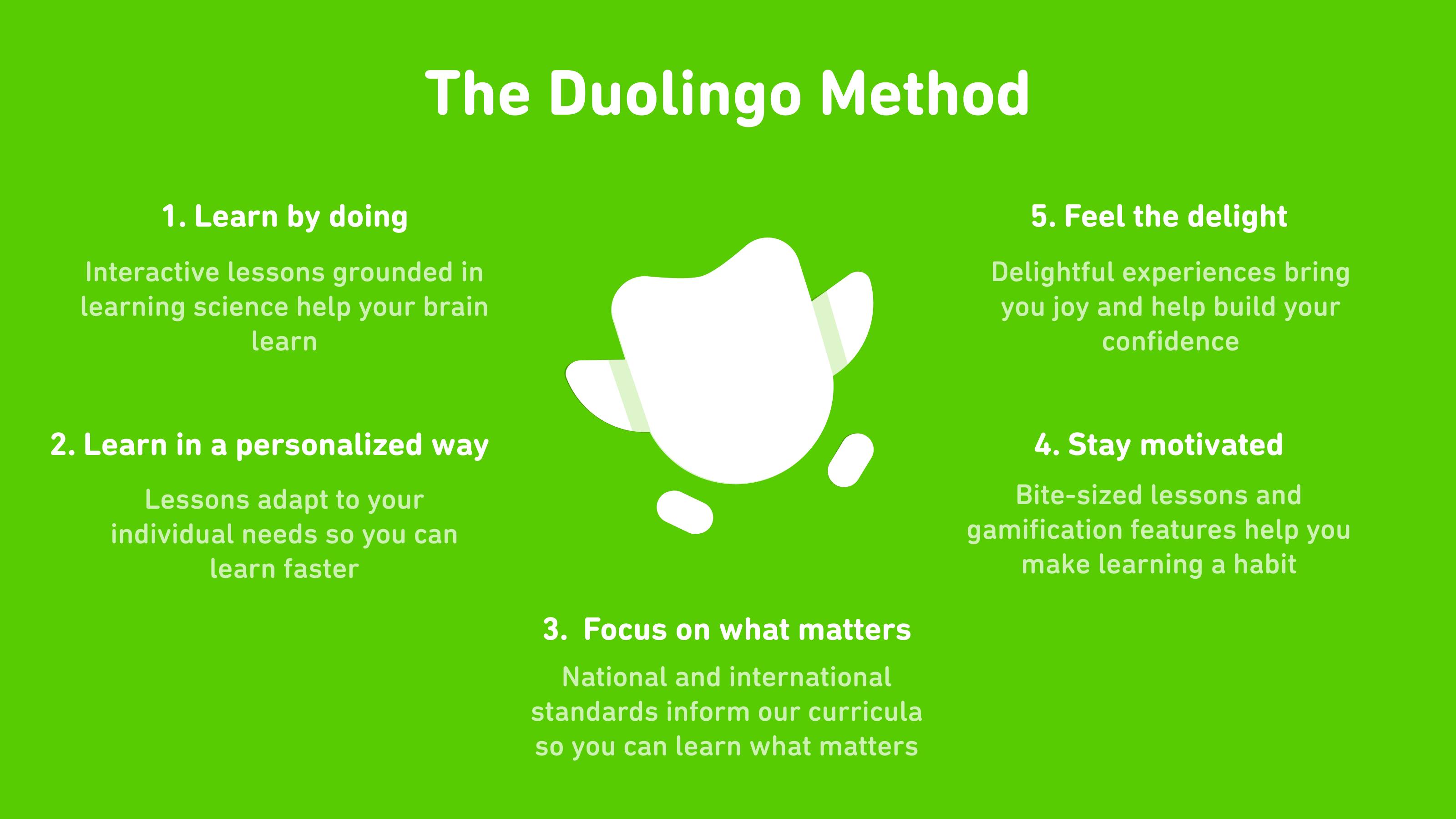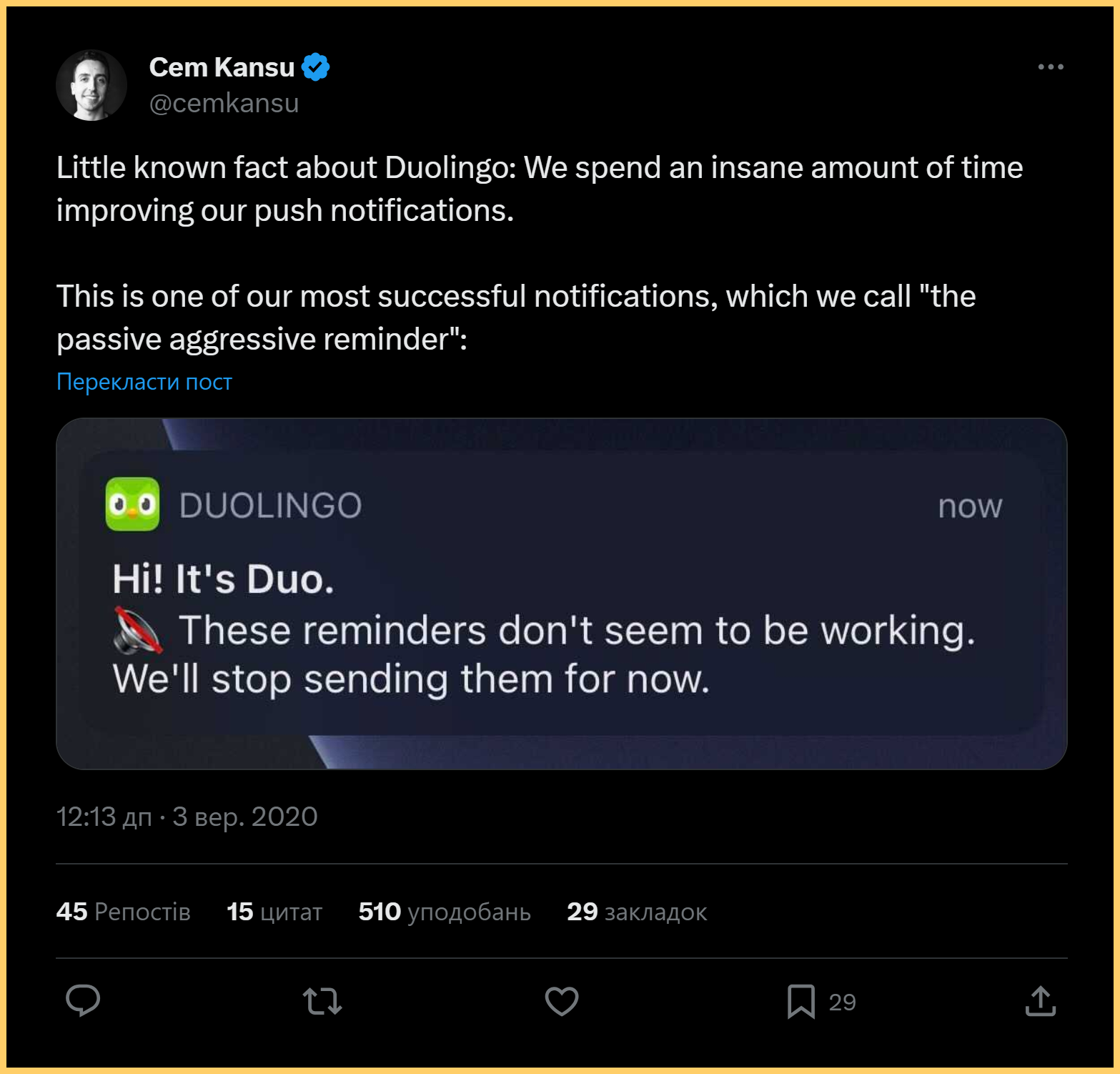Few things demotivate a business owner more than wasted efforts and investments. It seems like you’ve done everything to succeed: you’ve developed a great functional app, invested a large budget in product promotion, and are ready to welcome thousands of satisfied users. But you still don’t have them. What’s wrong?
According to Urban Airship research, 95% of new users who don’t receive notifications within the first 90 days leave the app. So, even if your app is a brilliant discovery, people won’t know why they need it without prompting.
What can you do about it? How can notifications solve this dilemma? Doesn’t it annoy users? At Solve Marketing, we’ve investigated these questions and are ready to explain everything using Duolingo as an example.
Case navigation:
- What are notifications and why are they needed?
- What is the Duolingo phenomenon?
- The power of notifications.
- The tone of Duolingo communication.
- How Duolingo notifications work.
What are notifications and why are they needed?
Notifications can be characterized as quick messages sent via apps to users’ devices. Modern notifications can include media and buttons, and can be highly personalized. By sharing information and updates, users can be encouraged to interact with the app again and again.
The point is that such communication goes beyond the app and is possible even when the phone or other device is inactive. From the marketing point of view, this is an effective tool for user interaction. Using this technology, you can not only attract and retain customers but also create a loyal community around the brand, as Duolingo has done. So let’s discuss the role of notifications and their capabilities in more detail using the case study of this company.
What is the Duolingo phenomenon?
Duolingo is undoubtedly the most famous app for learning dozens of languages in an interactive way. Since the beginning of 2011, the platform has attracted and retained more than 500 million users. How do they do it?
1. A clear goal.
The history of the startup’s development began with a simple mission: to make language learning accessible to all Internet users. Based on this, the founders decided to build a simple learning system by introducing gamification. It’s much easier to learn a language while playing, you’ll agree.
2. User motivation.
And if you motivate people with a constant competition with rewards, they will want to participate again and again. It’s nice to open the boxes with the rewards and see yourself on the winning podium, not to mention the victory dance of the app’s characters in your honor after each correct answer.
3. Unique approach.
A personalized approach to the knowledge acquisition process makes the app effective. For example, after a person makes a mistake, he or she has to return to a specific task after a certain time to pass the level. The effectiveness of such training has been confirmed for a long time, but not everyone has been able to implement the methodology so successfully.
4. Building loyalty to the company.
Next, Duolingo was able to unite learners around the world. A sense of belonging is what keeps people interested. Discussion boards, leaderboards, and communities have made learning social and fun.
In general, the company tries to convey 5 basic principles: learn by doing, have personalized lessons, focus on the main thing, stay motivated, and have fun.

But many apps use effective techniques, a game approach, and try to motivate users. And, of course, this does not guarantee success.
There is another crucial aspect that we have not yet mentioned. This is the topic of our research.
The power of notifications
Starting to learn a new language is not as difficult as maintaining interest and motivation. At first, we all think that nothing will happen if we miss one day of school. After all, we’re so tired today, and tomorrow we’ll get back to it. And then we remember that we haven’t practiced for a whole month. Duolingo knows better than anyone that the human brain works in such a way as to minimize overload.
Therefore, Duo the owl plays the role of a coach who encourages systematic learning and forms a habit. It never gets tired of reminding users to practice. In most cases, incessant notifications would be annoying and lead to uninstalling the app. But not in this case. Duolingo’s secret is a mutually beneficial relationship with users. “Just give a little time, and in return, get cool knowledge, bonuses, rewards, and happiness. How about that?”
The company uses three main types of user engagement:
- Behavioral. Efforts are aimed at forming a routine: see a notification > enter the app > practice for 10-20 minutes > get a daily reward. The goals in the app are divided into parts to make them easier to achieve and to show progress.
- Cognitive. The app emphasizes the benefits of daily practice in every possible way, rewarding your efforts and encouraging you to keep going because it’s so important to you to learn the language.
- Emotional. It’s hard to feel the positive results of regular classes in a day because it’s a long process. But with Duolingo, you can. The app assures you that you are on the right track and have made a huge contribution to your development in a few minutes. You get experience points, badges, and other rewards.
Duolingo’s communication tone
You’ve probably seen at least one meme about an app’s mascot and its messages. It’s no coincidence that social media considers such communication passive-aggressive.

Here’s what Cem Kansu, Head of Product, has to say about it:
“A little-known fact about Duolingo is that we spend an insane amount of time perfecting our push notifications.
This is one of our most successful notifications, which we call a ‘passive-aggressive’ reminder: “Hi, this is Duo. These reminders don’t seem to be working. We’re going to stop sending them for now”.

So, in addition to the tremendous effectiveness that Duolingo’s employees noticed, the company also received free promotion through social media posts. It turns out that people are much more interested in trying an app from a meme than from an advertisement.
Duo’s notifications became so recognizable that the company decided to move them into real life. On Resignation Day (the second Friday of January), a popular holiday in America when most people give up their New Year’s resolutions, the reminders appeared in Times Square.
This campaign was widely covered in the news and social media, thus cementing the success of the chosen strategy.

How Duolingo notifications work
For reminders to work, the user must first agree to them. The company also came up with a motivation for this action. The user is offered to open the box with bonuses within a limited period of time and asked if they want to receive a notification so that they don’t miss this opportunity. This mutually beneficial exchange is the beginning of the communication strategy.

Next, the program counts the days of continuous use of the app and completion of classes. If you forget about the training, your series is interrupted, you may lose your leadership position, and you will have to start over.
In addition to notifications, the app offers to display a widget on the home screen that shows your progress. This motivates you even more to take 10 minutes and save your progress. The app also sends notifications about training by email, shows leaderboards, and reminds you to collect your prizes. Owl Duo knows how to manipulate emotions, so it asks you not to upset it and come to the app or, on the contrary, to make it happy with your presence.
Moreover, when you have already fulfilled the plan for the day, Duolingo is not going to stop you. You will be offered to use a bonus. For example, the experience for the next lesson will double. You will gain more points and can become a tournament winner.
You can also get a box by inviting a friend to the app, watching an advertisement, or after completing a challenge.
Our conclusions
Having analyzed the successful case of the Duolingo learning app, we recommend that you do not ignore an important and direct channel for attracting new users and activating existing ones — notifications. There are many effective ways to use notifications for business purposes: offer bonuses and rewards, show users goals and motivate them to fulfill them, show the importance and effectiveness of targeted actions.
It is important to use the reminder tool correctly, approach the task strategically, and understand your audience.





